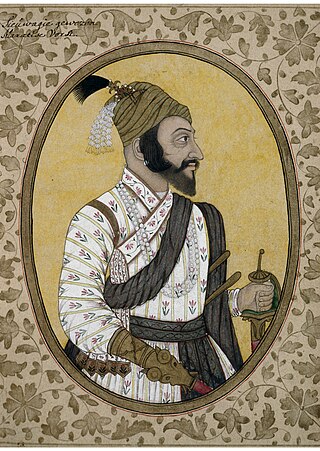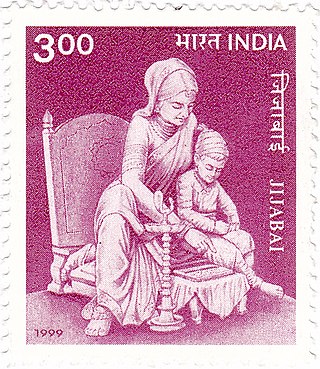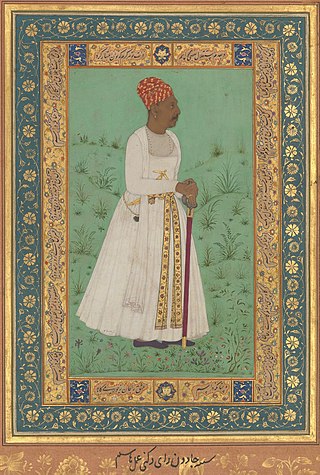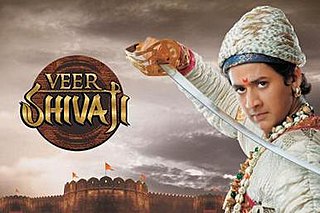Related Research Articles

Shivaji I was an Indian ruler and a member of the Bhonsle dynasty. Shivaji carved out his own independent kingdom from the Sultanate of Bijapur that formed the genesis of the Maratha Confederacy.

Shivneri Fort is an ancient military fortification located near Junnar in Pune district in Maharashtra, India. It is the birthplace of Chatrapati Shivaji Maharaj, the founder of Maratha Kingdom.

The Sultanate of Bijapur was an early modern kingdom in the western Deccan and South India, ruled by the Adil Shahi dynasty. Bijapur had been a taraf (province) of the Bahmani Kingdom prior to its independence in 1490 and before the kingdom's political decline in the last quarter of the 15th century. It was one of the Deccan sultanates, the collective name of the kingdom's five successor states. The Sultanate of Bijapur was one of the most powerful states on the Indian Subcontinent at its peak, second to the Mughal Empire which conquered it in 1686 under Aurangzeb.

Jijabai Shahaji Bhonsale , referred to as Rajmata Jijabai, was the mother of Shivaji, founder of the Maratha Kingdom. She was a daughter of Lakhujirao Jadhav of Sindkhed Raja.

Shahaji Bhonsale was a 17th century Indian military leader who served the Ahmadnagar Sultanate, the Bijapur Sultanate, and the Mughal Empire at various points in his career. As a member of the Bhonsle dynasty, Shahaji inherited the Pune and Supe jagirs (fiefs) from his father Maloji, who previously served the Ahmadnagar Sultanate. During the Mughal invasion of the Deccan, Shahaji joined the Mughal forces and served under Emperor Shah Jahan for a short period. After being deprived of his jagirs, he defected to the Bijapur Sultanate in 1632 and regained control over Pune and Supe. In 1638, he received the jagir of Bangalore after Bijapur's invasion of Kempe Gowda III's territories. Afterwards, he became the chief general of Bijapur and oversaw its expansion.

Maharani Tarabai Bhosale (née Mohite) was the regent of the Maratha Empire from 1700 until 1708. She was the queen of Rajaram I, and daughter-in-law of the kingdom's founder Shivaji I. She is acclaimed for her role in keeping alive the resistance against Mughal rule in Konkan, and acting as the regent of the Maratha Empire during the minority of her son, Shivaji II. She defeated Mughal forces of Aurangzeb in several battles and expanded the Maratha Empire.

Malik Ambar was a military leader and statesman who served as the Peshwa of the Ahmadnagar Sultanate and its de facto ruler from 1600 until his death in 1626.

Sangram Durga is a land fort situated at Chakan, Pune, Maharashtra, India. The original area of the fort was 65 acres, currently it is only 5.5 acres.
Santaji Ghorpade (1660–1696) was a Maratha general and held the esteemed position of the 7th Senapati within the Maratha Empire during the reign of Chattrapati Rajaram I. He is widely regarded as one of the foremost experts in Guerrilla warfare. Santaji Ghorpade, in collaboration with Dhanaji Jadhav, conducted a series of successful campaigns against the Mughals from 1689 to 1696. His strategic acumen was demonstrated through the adept utilization of tactics such as guerrilla warfare, ambushes, and swift mobility, ultimately resulting in effective defeats of the Mughal Army. In recognition of his valor, Rajaram bestowed upon him the title of Mamlakat-Madar in 1690.
Dadoji Kondadeo was an administrator of the Pune jagir and the nearby Kondana fort. He was appointed by Shahaji, a noble and general of the Adilshahi sultanate of Bijapur.

Saibai Bhonsale was the wife consort of Chattrapati Shivaji, the founder of the Maratha Empire. She was the mother of her husband's successor Chattrapati Sambhaji.
Morè is the name of a Maratha clan as well as a Mahar clan from the state of Maharashtra. Members of the More Maratha clan as well as the Mahar clan use the clan name as their surname. The totem associated with the clan is a peacock. Members of the Mahar clan worshipping the same Totem cannot intermarry. 'More' is also an exogamous clan in the Bhils of Maharashtra.

Prabalgad is a fort located between Matheran and Panvel and comes under the Raigad District in the state of Maharashtra, India.

Lakhuji Jadhav Rao, also known as Lakhuji Jadhav was a Maratha statesman and Mansabdar who initially served the Ahmadnagar Sultanate and later joined the Mughals. He was a prominent figure in the politics of Deccan. Lakhuji was a well-known member of Jadhav Rao clan descendants of the Yadavas of Devagiri. He was also a Jagirdar of Sindkhed Raja. He was father of Jijabai, and grandfather of Shivaji, who was founder of the Maratha Empire.
Shivaji was the founder of the Maratha Empire in the Indian subcontinent. This article describes Shivaji's life from his birth until the age of 19 years (1630–1649).

Veer Shivaji is an Indian historical drama series that aired on Colors TV from 2 September 2011 to 25 May 2012. The show focuses on the life of Shivaji, the 17th century founder of the Maratha Empire.
The Battle of Bhatvadi was fought in 1624, near modern Bhatodi Pargaon village in Maharashtra, India. The Ahmadnagar army led by Malik Ambar defeated a combined Mughal-Bijapur force led by the Bijapuri general Mullah Muhammad Lari.

The Bhonsle dynasty is an Indian Marathi royal house of the Bhonsle clan. The Bhonsles claimed descent from the Rajput Sisodia dynasty, but were likely Kunbi Marathas.
Earlier Malik Ambar had ceded territories of Ahmednagar and Berar to Mughals however in 1617 A.D he broke the treaty with Mughals, In 1619 A.D he along with his Bargi troops commanded by Maloji laid a Siege to the Fort of Ahmednagar which he had lost to Mughals.
References
- 1 2 Shivaji The Great Vol. I by Dr. Balkrishna p.53
- ↑ Salma Ahmed Farooqui (2011). A Comprehensive History of Medieval India: From Twelfth to the Mid-Eighteenth Century. Dorling Kindersley India. pp. 314–. ISBN 978-81-317-3202-1.
- ↑ V. B. Kulkarni (1963). Shivaji: The Portrait of a Patriot. Orient Longman. p. 27.
- ↑ Satish Chandra (2005). Medieval India: From Sultanat to the Mughals. Har-Anand. p. 316. ISBN 978-81-241-1066-9 . Retrieved 8 October 2012.
- ↑ G. H. Khare (1974). Studies in Indology and Medieval History. Joshi & Lokhande. p. 176.
- ↑ James W. Laine (2000). "A Question of Maharashtrian Identity: Hindu Self-definition in the Tales of Shivaji". In Meera Kosambi (ed.). Intersections: Socio-cultural Trends in Maharashtra. Orient Blackswan. p. 62. ISBN 9788125018780 . Retrieved 15 November 2022.
- ↑ Jagadish Narayan Sarkar (1977). History of History Writing in Medieval India. Ratna Prakashan. p. 7.
- ↑ Shivaji The Great Vol I, Dr. Bal Krishna, p.53
- 1 2 3 Chintaman Vinayak Vaidya (1931). Shivaji: the founder of Maratha Swaraj. C. V. Vaidya. pp. 10–15. Retrieved 8 October 2012.
- ↑ Historical Biography in Indian Literature by SP Sen p.226
- ↑ Charles Augustus Kincaid; Dattatraya Balavanta Pārasanisa (1968). A History of the Maratha People: From the earliest times to the death of Shivaji. S. Chand. p. 114. Retrieved 8 October 2012.
- ↑ Farooqui Salma Ahmed; Salma Ahmed Farooqui (2011). A Comprehensive History of Medieval India: From Twelfth to the Mid-Eighteenth Century. Pearson Education India. p. 314. ISBN 978-81-317-3202-1 . Retrieved 8 October 2012.
- 1 2 Stewart Gordon (16 September 1993). The Marathas 1600-1818. Cambridge University Press. pp. 41–44. ISBN 978-0-521-26883-7 . Retrieved 8 October 2012.
- ↑ Joseph G. Da Cunha (1900). Origin of Bombay. Bombay, Society's library; [etc., etc.]
- ↑ Govind Sakharam Sardesai (1957). New History of the Marathas: Shivaji and his line (1600-1707). Phoenix Publications. p. 58. ISBN 9788121500654 . Retrieved 8 October 2012.
- ↑ Richard M. Eaton (17 November 2005). A Social History of the Deccan, 1300-1761: Eight Indian Lives. Cambridge University Press. pp. 178–. ISBN 978-0-521-25484-7 . Retrieved 8 October 2012.
